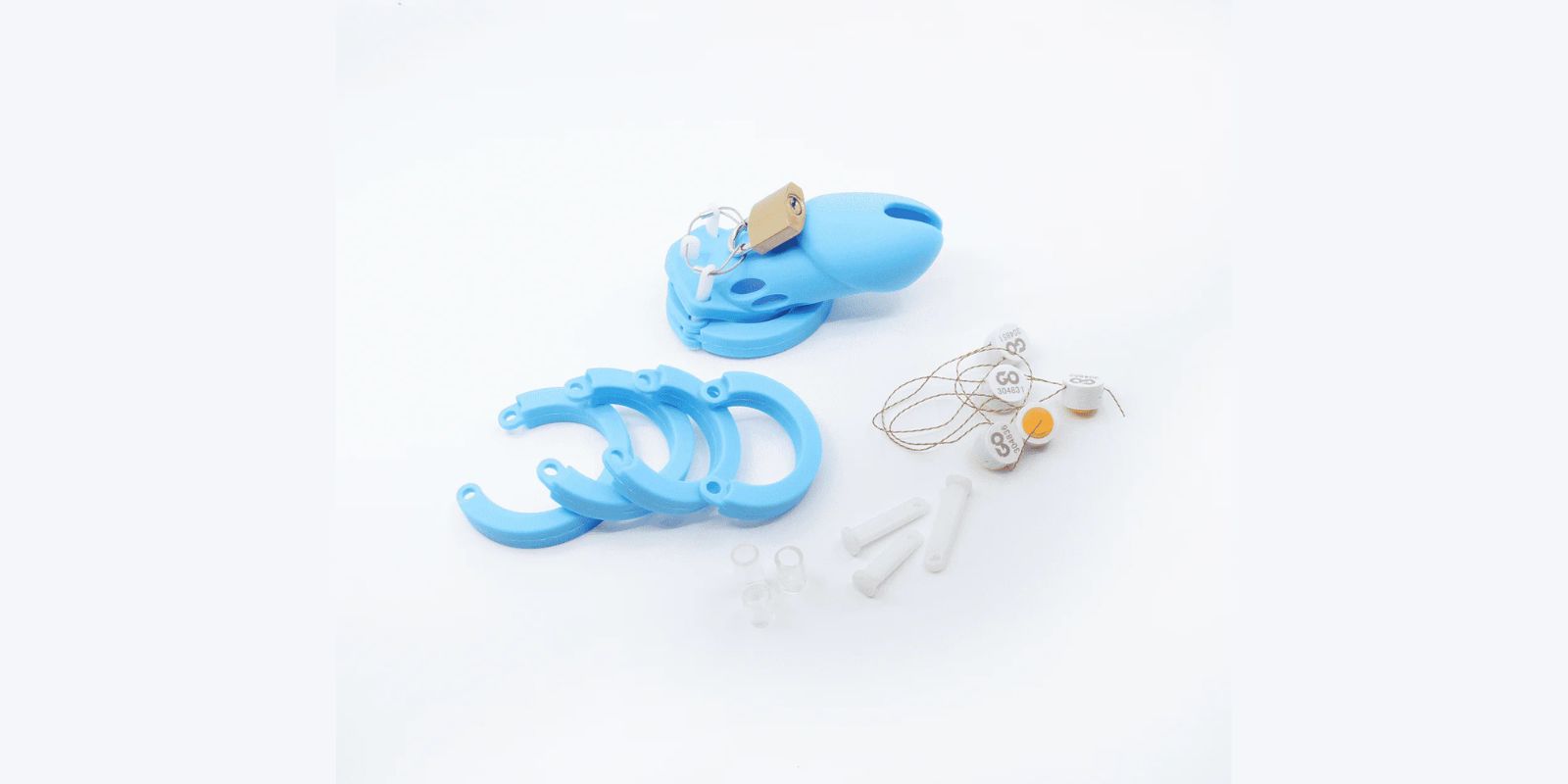Chaste Beginners Guide — How To Embrace Long-Term Denial Safely
Chaste Beginners Guide: Start slow — practice short, unmanaged denial sessions before locking into a device. Prioritise sizing, skin prep, and having a spare key. Read the safety and hygiene sections carefully.
Chastity stands out in the world of sexual exploration. Unlike most sexual endeavors that celebrate orgasm and release, chastity play intentionally delays or denies orgasm to heighten anticipation, deepen power dynamics, and create prolonged erotic tension. This guide is written for curious newcomers, partners supporting each other, and anyone who wants a safer, more informed start to male chastity. You’ll find practical tips, safety notes, sizing and device advice, and resources so your first steps are comfortable and rewarding.
Table of Contents – Chaste Beginners Guide
- A Beginner’s Guide to Navigating Male Chastity
- Mastering Orgasm Denial
- Sizing Matters
- Selecting the Right Style
- Preparing Your Skin
- Lubrication: A Must
- Easing Into It: The Importance of Time
- Getting Comfortable: Incremental Steps
- Sleeping Considerations
- Nighttime Adjustments
- Always Have a Spare Key
- Patience is Your Ally
- Relish Your Caged Journey
- Surrender the Key
- FAQ
- Your Chaste Journey: Embracing Trust & Discovery
- Further Resources

A Beginner’s Guide to Navigating Male Chastity
Male chastity can transform how you experience arousal, intimacy, and control. At its core, chastity is a consensual exchange — often involving a keyholder — that focuses attention away from release and toward teasing, trust, and psychological play. For beginners, understanding the physical needs (sizing, hygiene, skin care) and the emotional needs (communication, boundaries, aftercare) is essential for a safe and fulfilling practice.
Below you’ll find expanded, practical advice for each step of the journey — from first trial wears to longer-term dynamics. Where helpful, we highlight common mistakes and safety measures so you can enjoy chastity without unnecessary risk.
Mastering Orgasm Denial
Start mentally before you start physically. Orgasm denial is as much a psychological practice as it is a physical one. Try short, self-managed denial sessions (for example: hold off for a few hours or a single day) to learn how your body and mind react. Notice triggers, mood shifts, and how arousal changes over time—these observations make the locked experience far smoother.
Communication with a partner or keyholder is crucial. Discuss limits, hard and soft safewords, and what constitutes an emergency. Because long-term denial can affect mood and libido, schedule check-ins and be ready to adjust the arrangement. Always prioritize consent and wellbeing over the fantasy.
Sizing Matters – Chaste Beginners Guide
Choosing the right size device is one of the single most important decisions you’ll make. A cage that’s too tight causes pain, irritation, and possible circulation problems; a cage that’s too loose defeats the point. Measure carefully when flaccid (not erect) and follow manufacturer sizing charts. When in doubt, choose a slightly roomier size for your first device and upgrade once you understand how your body tolerates long wear.
If you buy online, check return and exchange policies and avoid impulsive purchases while aroused. Many dedicated chastity retailers publish sizing guides and community advice — use those resources. For example, the product collections and sizing notes available at Male Chastity can help you compare styles and ring sizes (note: follow each product’s specific instructions).
Selecting the Right Style
There are several broad style categories: fully-enclosed cages, tube or ball-trap designs, soft silicone models, and metal cages (steel or titanium). Each offers a different balance of security, hygiene, and comfort. Beginners often prefer ventilated or open designs that allow for airflow and easier cleaning.
Think about lifestyle: if you’ll wear the device during work, commuting, or exercise, pick a low-profile design and consider the material’s weight. If aesthetics and psychological control are the primary drivers, a heavier metal unit may feel more symbolic and satisfying. Whatever you pick, always weigh comfort and safety above symbolism.

Preparing Your Skin
Skin readiness prevents chafing, irritation, and painful hotspots. Keep the area trimmed — not fully shaved — to reduce hair tugging and friction against the ring. Clean, dry skin reduces bacterial buildup and soreness. Consider a gentle daily wash and gentle drying before application.
If you have sensitive skin or a known allergy (e.g., to nickel), choose hypoallergenic materials such as medical-grade silicone or titanium. Test new materials with short trial wears and consult healthcare guidance if you notice unusual redness, swelling, or persistent discomfort.
Lubrication: A Must – Chaste Beginners Guide
Lubricant is essential for comfort when fitting rings, inserting cages, and during any adjustments. Use a small, water-based lubricant for metal and silicone devices unless the manufacturer specifies otherwise. Avoid oil-based lubricants with some materials as they can degrade silicone over time.
Apply sparingly to ring contact points to prevent skin pinching, and reapply if you notice increased friction. Lubricant also helps when reinserting a device after cleaning and can reduce micro-abrasions that lead to infection if neglected.
Easing Into It: The Importance of Time
Don’t lock in for extended periods on your first attempt. Start with short sessions (1–2 hours) in a familiar, low-activity setting. Check the skin immediately after removal and again the next day. Gradually increase wear times as confidence and tolerance grow.
A progressive schedule also helps with the psychological aspects of chastity. Short trials let you both find what teasing and aftercare routines work emotionally — essential if a partner is the keyholder.
Getting Comfortable: Incremental Steps
Begin when you’re calm and flaccid; this reduces the chance of pinching during fitting. Wear the device for an hour, then two, then a full day, noting any discomfort or irritation that develops. Keep basic supplies nearby: lubricant, antiseptic wipes, a small mirror, and an emergency key or removal tool.
Plan for contingencies: if you feel numbness, severe swelling, or an inability to urinate normally, remove the device immediately (or seek help). These are warning signs that the device is compromising circulation or causing acute problems.
Sleeping Considerations: Take It Slow
Sleeping while locked introduces nocturnal erections and shifting pressure points. Before attempting overnight wear, become comfortable with daytime and evening sessions. If you do sleep while locked, use loose, breathable sleepwear and sleep positions that avoid pressure against the device.
Chaste Beginners Guide – Some people find masturbating before bed (if permitted by the dynamic) reduces strong nocturnal erections; others prefer to avoid this. Experiment during weekends to minimize disruption to work or wellbeing.
Nighttime Adjustments: Handling Discomfort
Waking from an erection is common. Gentle walking or changing positions can reduce erection intensity faster than lying still. If you consistently wake in pain, remove the device and reassess sizing or device type — prolonged painful awakenings are not normal and should be addressed.
For chronic sleep disruption linked to chastity, consider scheduling lock times to avoid the highest-risk hours or temporarily switching to a more forgiving device during sleep.
Always Have a Spare Key
The fantasy of the keyholder keeping the only key is powerful — but practical safety demands redundancy. Store a spare key in a secure, prearranged location and ensure a trusted person can access it in emergencies. Chaste Beginners Guide – Options include a sealed envelope with instructions, a locked safe with a second key accessible to a designated helper, or a coded combination lock known to a partner.
For public safety, avoid leaving the spare key in obvious places that could compromise your privacy or fetish safety. Discuss emergency access procedures with your partner before your first long lock-up.
Patience is Your Ally – Chaste Beginners Guide
Chastity is a slow-burn practice — rushing into 24/7 play rarely leads to positive outcomes. Your body and your relationship need time to adapt. Small, consistent sessions build tolerance and the psychological reward of prolonged teasing.
Set gradual milestones and celebrate small progress. Chaste Beginners Guide – Patience reduces mistakes and helps the dynamic mature into something sustainable and deeply satisfying.
Relish Your Caged Journey
Over time, many find the simpler acts — ritualized key exchanges, teasing messages, or scheduled releases — become the most meaningful. The experience often shifts from pure physical arousal to emotional connection, anticipation, and ritual. Relish those subtle shifts; they’re a big part of chastity’s unique appeal.
Don’t be afraid to adapt. What feels thrilling at first may evolve; the most sustainable chastity dynamics are those that evolve with the people involved.
Surrender the Key
Relinquishing the key is a big psychological step. Practice trust-building outside chastity (transparent communication, reliability, shared boundaries) before committing to long-term keyholding. For many couples, the act of surrendering the key becomes a powerful ritual of trust, intimacy, and emotional surrender.
Set clear expectations: who controls releases, what negotiation looks like, and how to handle emergencies. When trust is established and boundaries respected, surrendering the key amplifies the emotional intensity of the experience.
FAQ – Chaste Beginners Guide
Q1: How long can I safely wear a chastity device?
A1: Start with short sessions (1–4 hours) and gradually increase. Many people progress to day-long wears and eventually multi-day periods, but “safe” duration depends on correct sizing, material, hygiene, and personal tolerance. Remove the device immediately if you experience severe pain, numbness, urinary problems, or signs of infection.
Q2: Can I urinate while wearing a device?
A2: Most male chastity devices are designed to allow urination, but flow can be altered. Ensure the device’s design accommodates comfortable and complete urination; if your device obstructs urine flow or causes retention, remove it and seek a different model and medical advice if necessary.
Q3: How do I clean a device while locked for long-term wear?
A3: Ventilated designs allow periodic rinsing; for fully enclosed devices you’ll need scheduled removal for deep cleaning. Follow manufacturer cleaning instructions (usually warm water and mild soap or device-specific cleaners). For guidance on hygiene and product care, reputable sources and product pages (such as the cleaning guidance on malechastitydevices) are useful references.
Q4: What materials are best for sensitive skin?
A4: Hypoallergenic materials like medical-grade silicone and titanium are best for sensitive skin. Avoid nickel-plated metal if you have a nickel allergy. Test any new material with short wear times before committing to prolonged use.
Q5: When should I see a doctor?
A5: See a medical professional immediately if you experience severe swelling, persistent numbness, inability to urinate, fever, increasing pain, or signs of infection (pus, spreading redness). For non-urgent concerns (e.g., repeated chafing), consult a healthcare provider to discuss material choices and aftercare routines.
Your Chaste Journey: Embracing Trust & Discovery
Chastity is a journey of trust, curiosity, and self-discovery — not a checklist. Begin slowly, prioritise safety and communication, and allow the practice to evolve with your body and relationship. The rituals, the teasing, and the eventual release (if that’s part of your dynamic) all carry amplified meaning when built on consent, preparation, and patience. Whether your interest is exploratory or lifestyle-oriented, approach chastity with care and playfulness — and enjoy the surprising depths it can add to intimacy.


